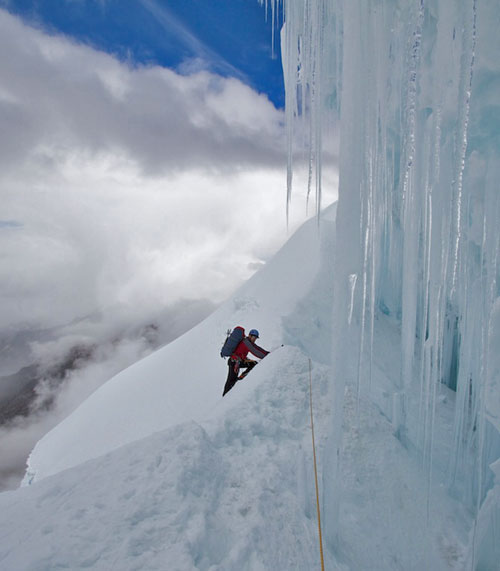From the San Juan Mountain Guides Website, here's the gear list for Alpamayo:
 |
| 6000 Meter Double Boots with Crampons |
General Equipment
Duffel Bag: Large durable bag for airline and in-country travel and organization.
Backpack: Internal frame, 50-60 liters max. Guides’ pick: Osprey Aether 60 or Variant 52
Sleeping bag: Down or synthetic bag rated between 15-20 degrees with compression stuff sack. Guides’ pick: Neutrino Endurance 400
Sleeping Pad: Full-length Therm-a-Rest air mattress.
Pocket knife: 2-3 inch blade, simple, light
Cup/Bowl & Spoon: Versatile plastic/lexan type.
Small thermos: Optional, but nice to have
Water bottles: 2 liters combined capacity; bottles or bladder. Guides’ pick: Nalgene or Platypus
Water Bottle Insulators: OR or similar sleeve type water bottle insulators
 |
| Weighing gear in Talkeetna Alaska |
Climbing Equipment
Adjustable Trekking Poles
Harness: Adjustable leg loops are essential.
Locking carabiner (2): Pear shaped, wide mouth.
Non-locking carabiners (4): Wire gate biners are best
Helmet
Boots: Climbing boots. Double boots or insulated single boots with zippered gaiter.
Crampons: Step in crampons. Guides’ Pick: BD Sabretooth
Ice Axes: 2 Technical Ice Tools. Guides’ Pick: BD Cobra
Clothing and Personal Equipment
Travel Clothing: 2 sets of travel/town clothing is usually suffiicient
Hiking boots: Lightweight hiking boots or approach shoes for acclimatization hikes and around town.
Socks: 2-3 pair of medium weight wool or synthetic blend socks.
Base layers: Synthetic t-shirt and synthetic long underwear
Mid-weight Layer: For over your long underwear and under other external layers. Guides’ Pick: OR Centrifuge Jacket
Soft shell pants: Warm enough for cool mornings and nights, yet light enough for warm days. Guides’ Pick: OR Cirque Pant
Soft shell jacket: Your workhorse jacket with a hood. Guides’ Pick: OR Alibi Jacket
Insulated Jacket: Down or synthetic with a hood. Guides’ pick: OR Virtuoso Hoody
Hard shell jacket: waterproof and breathable, no insulation. Guides’ Pick: OR Axiom Jacket
Gloves: 3 pair. 1 mid-weight, 1 heavy-weight, 1 light-weight. Bring mittens if you get cold hands easily.
Hand Warmers: 2 – 3 packets to stick in your gloves.
Hats: one with brim, one for warmth
Balaclava: BUFF’s are also acceptable.
Sunglasses: With Category 4 lenses.
Goggles: A standard paid of ski goggles will suffice.
Sunscreen and lip balm: water/sweat-proof. SPF 50 or higher recommended.
Headlamp: with extra batteries. Guides’ pick: Black Diamond Spot
Toiletries: Toilet paper, baggie for used TP, toothbrush/paste, wet wipes, hand sanitizer, etc.
Personal first-aid kit: for your personal meds/needs; guide will have a large one as well
Stuff sacks: for convenient packing
Digital Camera
Book and/or iPod/iPad
Lunch food: Everything you eat between breakfast and dinner. May include: bagels, dried meats, cheese, trail mix, candy bars, peanut butter, etc…

















